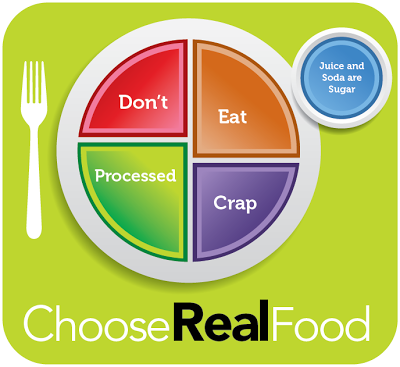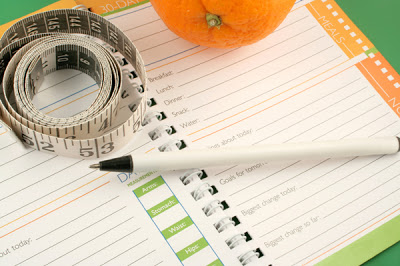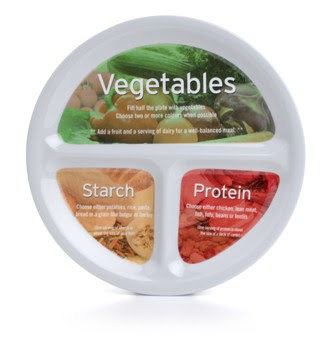3 Simple Steps To Help You Get Real About Your Eating. Tips on Keeping a food journal, reading food labels, and portion sizes.
At about a month into your new years resolution you may be starting to lose steam. Want to stick to your New Year’s resolution? And I mean really stick to it? Then you need to get real about your eating.
 |
| http://thepaleoman.com |
It has been suggested that 80% percent of weight loss is your diet, and 20% is exercise. Now this 80/20 ratio is a real simple way to look at it, because it fails at addressing about 100% why people gain weight. Anyway the important thing to remember when it comes to losing weight and keeping it off is that your diet does count for large percentage of your weight. It’s basic math really, calories in should be less than calories burned, but how do you keep track?
Stop Mindless Eating:
If you are looking to consume less calories, but still eat and feel full then you need to get real about what your eating. Research shows that many individuals who are overweight actually unconsciously block out the foods they’ve eaten in the run of a day; it’s not anything they’ve done on purpose, but it is this mindless eating that forces our brains to forget the calories coming in thus resulting in overeating. When we are not remembering the foods we’ve eaten in the run of a day this results in some major bad choices that we are not even cognitive of; I’ve compiled a couple things to help prevent this from happening.Be Honest With Yourself:I hear it all the time “I don’t know how I’m not losing weight; I eat really healthy” okay so I’m going to be harsh here, but bare with me. When I hear this I’m immediately sceptical because chances are you don’t wake up obese (as much as we feel that way sometimes), this is an extended period of bad habits and poor eating.
If you were eating healthy you would lose weight (unless you have thyroid issues and a quick blood test can clear that up). If you are eating healthy, and exercising there is no reason why you should not be losing weight. If you practicing a healthy lifestyle and you’re STILL not losing weight something is wrong with your diet or exercise plan, and you’re just not seeing it. Conversely, if you aren’t seeing any movement on the scale or with the inches on the measuring tape, but you feel like you are working really hard, you might also want to consider that your body weight is where it should be and you shouldn’t be trying to fight it check your BMI for conformation.
Disclaimer: The only time you should be trying to lose weight is if your BMI, and body fat percentages are out of the prescribed normal range because once you are out of the range prescribed by a professionals that is putting you at risk of heart disease, diabetes, stroke, and so many other health concerns. If your BMI is in the normal range and you happen to be one of those freaks of nature that eats burgers everyday and doesn’t gain a pound that doesn’t mean you are void from health concerns; you should consider eating for health reasons because eventually it will catch up to you.
You can check your BMI here : http://www.nhlbisupport.com/bmi/
Stop Making Excuses:
If you want to lose weight because you feel like it is becoming a risk for your health you need to see things for what they are. I hear it all the time “oh i’m going to have these chocolates because I had a really hard day” or “I’m going to get McDonald’s because I have an appointment after work and I just don’t have time”. You know you have an appointment after work: you booked it, so stop pulling the wool over your own eyes and plan ahead to have something ready when you get home. We shouldn’t ever be eating anything as a reward or restrict as a punishment; food should be eaten as nourishment plain and simple.
The only way you are going to lose weight is if the calories coming in is less than the calories you burn off, and a lot of times those calories coming in are sneaky little buggers, and they come in the form of sugary salad dressings (10 grams), or full fat mayo in youf chipotle sauce at subway (9 grams of fat), or your triple whip cappuccino (490cal). If you’re having the 500 cal cappuccino you just ate your dinners worth of calories in your Starbucks cup. So let’s not force anyone to skip their dinners, and let’s just make better choices from the get-go. You can still have a cappuccino, but there is no need of it being 500 calories; try skim milk, and skip the sugary syrups and maybe limit them to a Saturday afternoon treat.
3 Simple Steps To Help You Get Real About Your Eating.
Keep a food journal:
Write down EVERYTHING you eat, and mean everything from sun rise to sunset. Keep track of the time you ate and how much you ate.
Include: nutrition information: calories, fat, carbs, protein, fibre
Identify your danger zones (places, routines, experiences)
Assess your reasons for eating (emotions or stress related?)
Gauge appetite and/or cravings
Track portion sizes
Record feelings before and after eating
Track you food groups, try to reach as many of the food groups as possible in one meal.
You don’t need to include all of these things, they are just examples to get you thinking. Work with what you know will work for you. I always get my students to do this at the beginning of a food and nutrition unit because it really puts things into perspective. For my students after school is their worst time for poor eating because they are often home by themselves and go for Toaster Strudels or Pizza Pops because it’s quick and easy. Once you begin to track trends you can work to prevent them.
Read your labels:
If you want to get real about your eating you need to stop mindless eating. You can’t change what you don’t acknowledge, and so you need to know what is in your food before you put it into your body. You wouldn’t drink a litre of motor oil, but yet you are unknowingly putting things into your body that are equally as harmful in the long run.
Tip: The most important things to remember when making food choices at the grocery store is to try to stay in the outer parameters of the store.
Tip: Choose as many produce items as your budget allows, or opt for frozen fruits and vegetables.
Tips: Choose lean proteins from fresh fish, and meats
Tip: Fill up the rest of your cart with high fibre (brown carbs), low sugar and low sodium items. ZERO TRANS FAT.
Avoid high sodium (should be less than calories per serving).
Avoid high sugar (if it is in the first four ingredients don’t eat it)
Eat high fibre 30 plus grams a day. choose breads with at LEAST 2 grams per serving.
Eat lean protein foods; fish, chicken, turkey, beans, lentils.
Limit saturated and trans fat: add these two numbers together if they add up to be more than 3 grams: don’t eat it.
When you look down at your meals could half the meal be considered as a fruit or vegetable, 1/4 lean protein and 1/4 carb? NO: rethink the meal YES: enjoy your lovely meal and look forward a happy healthy lifestyle.
Get real about serving sizes:
Most of the time we eat on average 3 times the amount of food we actually need. Most of us don’t harvest our foods anymore, and so food is always readily available to us including high fat sugary foods. Tip: Try eating with your non-dominant hand; it will slow you down and allow your brain time to catch up.
Tip: Try eating on 9 inch plates, and better yet try eating at home at your kitchen table rather than in front of your television or in the car on the way home from work. When you eat while watching TV you eat on average an extra 300 hundred calories, thats a good swim you just ate in front of Jeanne Beker.
| Food | One Serving Equals . . . |
| Breads, pasta, cereal, cooked grain, etc. |
|
| Fruits |
|
| Veggies |
|
| Meat, chicken, or fish | |
| Dairy |
|
| Nuts |
|
** compliments of www.fitsugar.com
Ultimately the bottom line is that you have to want the change, and you have to want to admit that what’s going on right now isn’t working. If you are up half the night hacking up a lung, or you have mad heart burn; you have some diet troubles my friend. Also remember that it isn’t all about weight loss, it’s about getting real with your food, and the food you choose to put in your body. Your body does SO much for you, and you need to do good things back. There are so many benefits to weight loss that fitting into a pair of skinny jeans shouldn’t be the only one; disease prevention, having more energy, sleeping better, having better relationships, feeling more confident are just a few.
So here’s to lookin’ at you knew you kid!
sincerely,
sp
*Images provided by google
Source: http://feedproxy.google.com/~r/ShortPresents/~3/zrGhlmS_D7Y/get-real-about-your-eating.html







